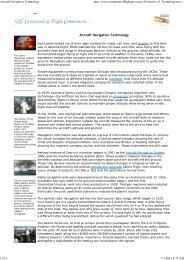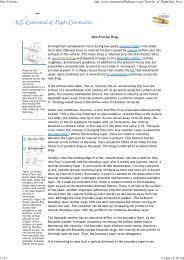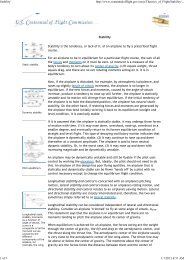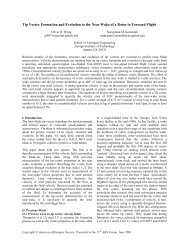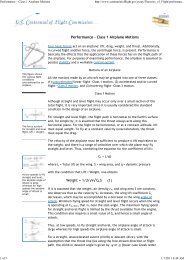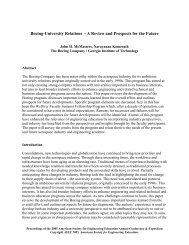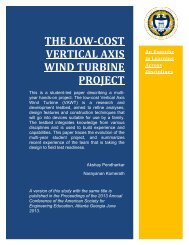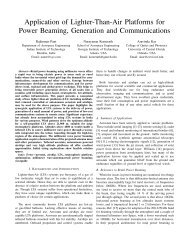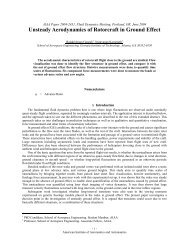Optimization of a Vertical Axis Micro Wind Turbine for Low Tip ...
Optimization of a Vertical Axis Micro Wind Turbine for Low Tip ...
Optimization of a Vertical Axis Micro Wind Turbine for Low Tip ...
Create successful ePaper yourself
Turn your PDF publications into a flip-book with our unique Google optimized e-Paper software.
I. Introduction<strong>Vertical</strong> axis wind turbines <strong>of</strong>fer a safe, inexpensive solution <strong>for</strong> <strong>of</strong>f-grid power generation in remoteareas. They can be located closer to the ground than horizontal axis machines. The rotational speeds andblade stresses are much lower than those on horizontal axis machines <strong>of</strong> the same power level, and henceblade technology can be brought down to levels that are compatible with construction and maintenanceusing locally available skills and materials. However, the VAWT is a complex machine with low efficiency,operating with unsteady aerodynamics and strong interactions between the flows around its components.VAWT operating characteristics are also highly complex. These machines cannot start themselves exceptthrough drag-based devices and cannot reach optimal operating speeds without external drives. Their powergeneration depends very strongly on the tip speed ratio, the ratio <strong>of</strong> blade speed to wind speed. Optimaloperation typically occurs at tip speed ratios between 3 and 5, meaning that the turbine speed must exceedwind speed by a large factor. To reach such speeds, a motor is typically used. For optimal operation, thecontrol system must then reverse the direction <strong>of</strong> power flow from motor to generator mode and keep themachine in a viable tip speed ratio regime. To make the device suitable <strong>for</strong> its intended role, these operationsmust become routine and adapt to the local environment. Such a state <strong>of</strong> technical development requires athorough understanding <strong>of</strong> all aspects <strong>of</strong> machine characteristics.The objective <strong>of</strong> the work described in this paper is to develop a VAWT testbed that can be used toenable prediction and optimization <strong>of</strong> such machines. Progress towards this objective has taken a meanderingpath. 1 A constraint imposed at the beginning was that all rotating parts (which are typically very expensiveto buy in remote locations) were to be obtained exclusively from bicycles, or at most, motorcycles. Both<strong>of</strong> these vehicles are freely available in most parts <strong>of</strong> the world, and their operation and maintenance arefamiliar to local people—even children—<strong>of</strong> all socioeconomic levels. Initial designs studied the possibility<strong>of</strong> using blades that were highly flexible and had very simple geometry. <strong>Vertical</strong> window blind slats wereused as blades, their camber providing some slight bending stiffness. Given that the blades were to beinexpensive, we investigated the possibility <strong>of</strong> using double blades arranged in biplane fashion as a way toincrease power output without substantially increasing the solidity or the number <strong>of</strong> arms. An aluminumdouble blade attachment was invented to hold the cambered, thin-plate blinds at the top and bottom. Aversion with four double blades was initially tested in a low-speed wind tunnel but quickly changed to threedouble blades to avoid sub-harmonic swaying <strong>of</strong> the mast. Both the three-bladed and four-bladed versionsexhibited a torque well in the azimuth range between 90 ◦ and 180 ◦ (where the blade was advancing into thewind) due to blade stall. This prevented self-starting even when Savonius-type drag tubes were added. Thisproblem was resolved by adding a static guide vane in this azimuth range to redirect the wind. A 1 m × 1 mmodel reached over 250 rpm in wind speeds up to 45 ft/s at the exit <strong>of</strong> an open-return low speed windtunnel. Centrifugal bowing <strong>of</strong> the blades was controlled by tying the blades to the mast in the middle usingnylon threads. A 2 m × 2 m version was then developed using the same technology <strong>of</strong> vertical blinds andtested in the settling section <strong>of</strong> a closed-return tunnel, where there were still strong fluctuations in the winddownstream <strong>of</strong> the tunnel fan blades. This experiment failed completely, as the blinds proved to have toolittle torsional stiffness and fluttered out <strong>of</strong> control as the machine began to turn, driven by the drag tubes.In both this and the 1 m × 1 m version, the peak speed reached actually increased when the lift-generatingblades were removed and the machine was operated with only Savonius drag tubes. The upper and lowerarm assemblies were then rotated 30 ◦ with respect to each other to slant the blades and thus distribute thepower generation more evenly. The blades were built with low Reynolds number airfoil sections, wooden ribs,a PVC pipe as the main spar, and PVC ro<strong>of</strong>-flashing sheets wrapped over the templates and stapled at thetrailing edge to <strong>for</strong>m the torsion box and skin. The attachments were PVC tube T-joints, thereby keepingthe construction technology and parts availability at the desired levels. This version generated mechanicalpower levels <strong>of</strong> over 60 W in strong winds. A larger model 6 ft in diameter was then developed, this timeintended to survive high wind speeds in a 2.54 m × 2.74 m wind tunnel. This is ultimately intended <strong>for</strong> useby coastal communities and designed to survive winter winds. Accordingly the construction used heaviersteel parts and blades constructed with wood, high-density foam, and fiberglass/resin skins.2 <strong>of</strong> 11American Institute <strong>of</strong> Aeronautics and Astronautics
Figure 2. Power coefficient vs. tip speed ratio <strong>for</strong> various solidities (Sandia). 4Figure 3.Comparison <strong>of</strong> Georgia Tech and Sandia per<strong>for</strong>mance predictions at 0.27 solidity.Figure 4.Comparison <strong>of</strong> Georgia Tech and Sandia per<strong>for</strong>mance predictions at 0.18 solidity.based torque. <strong>Low</strong> Reynolds number blade aerodynamic data were interpolated from Sheldahl and Klimas. 7Below Reynolds numbers <strong>of</strong> 10,000 data are not available, and in this region constant Reynolds number wasassumed, improving correlation with predicted power curves from Sandia 4 as shown in Figures 3 and 4. Thedashed black line is the Sandia per<strong>for</strong>mance prediction utilizing single streamtube theory, while the solidline is the Sandia per<strong>for</strong>mance prediction utilizing multiple streamtube theory.4 <strong>of</strong> 11American Institute <strong>of</strong> Aeronautics and Astronautics
Figure 5.Diversion control mode wiring.III.Experimental SetupIII.A.Belt DriveA V-belt drive was used to transfer power between the turbine shaft and the motor-generator shaft. Ideally,the pulley on the turbine shaft would be larger than that on the motor-generator shaft when the turbine isrunning the motor and vice versa when the motor is running the turbine. However, since it was deemed toocomplicated/expensive to implement a mechanism <strong>for</strong> changing gears automatically, a gear ratio <strong>of</strong> 1:1 wasused.III.B.Charging CircuitThe use <strong>of</strong> a motor-generator to run the turbine up to operating speed requires changes to be made to thetypical charging circuit, since most manufacturers <strong>of</strong> renewable energy (RE) charge controllers assume aturbine will be purely wind-powered. Figure 5 shows the original circuit which was modified in order to runthe motor <strong>of</strong>f <strong>of</strong> the battery bank. The charge controller does not regulate the voltage to the battery whenin diversion control mode. Instead, it only monitors the voltage <strong>of</strong> the battery and switches the circuit tothe dump load when it sees that the battery is fully charged. When this happens, excess energy will bediverted to the diversion load and dissipated as heat. A pair <strong>of</strong> fuses was used to protect the battery andsensitive components from spikes in voltage and current. The switches in Figure 5 can be used to manuallydisconnect the motor from the battery and/or the battery from the charge controller.To keep the turbine spinning in the same direction regardless <strong>of</strong> whether the motor is running the turbineor vice versa, a DPDT switch has been included in the circuit. Figure 6 shows the modified circuit in thecharging configuration; the DPDT switch is in the upper left portion <strong>of</strong> the image. When both the renewable5 <strong>of</strong> 11American Institute <strong>of</strong> Aeronautics and Astronautics
Figure 6.Modified circuit.energy and battery switches are closed, the current will flow clockwise, and the VAWT will start chargingthe battery by running the motor-generator. If the battery has a higher voltage than the motor-generator,the diode will prevent it from running the motor. On the other hand, when the VAWT is experiencingtrouble self-starting, the DPDT switch is flipped to the run position, and the battery switch is opened. Thecurrent will flow counterclockwise, and the motor-generator will run the shaft, spinning the turbine up tothe optimum tip speed ratio. Once the optimum tip speed ratio is reached, the DPDT switch can be flippedback to the charging position, and the battery switch can be closed again.III.C.Rope Brake DynamometerA rope brake dynamometer was used to test the power output <strong>of</strong> the wind turbine model in a low speedwind tunnel, where the wind speed can be made steady and uni<strong>for</strong>m. The setup consisted <strong>of</strong> a rope whichwas wrapped around a pulley on the bottom <strong>of</strong> the turbine; this rope was fixed on one end and held a weighton the other as shown in Figure 7. By recording the torque from the weight as well as the angular velocity<strong>of</strong> the turbine when subjected to a given freestream velocity, power was determined from Equations (1) and(2).T = W r (1)P mechanical = T ω (2)6 <strong>of</strong> 11American Institute <strong>of</strong> Aeronautics and Astronautics
Figure 7.Rope brake dynamometer.IV.ResultsIV.A.<strong>Low</strong> <strong>Tip</strong> Speed Ratio <strong>Wind</strong> Tunnel TestsDuring testing, the maximum tip speed ratio reached by the 6 ft VAWT was only 0.6. However, the predictedC P curve generated by the VAWT simulation indicates that peak efficiency is not reached until the turbineis spinning at a tip speed ratio <strong>of</strong> almost 3. From the wind tunnel testing, it is obvious that the turbine isnot capable <strong>of</strong> reaching such a tip speed ratio on its own (at least not in safe weather conditions), but onesolution is to attach a motor or some other drive system to the turbine which spins it up to the necessaryspeed be<strong>for</strong>e shutting <strong>of</strong>f. Indeed, this approach is taken by many manufacturers <strong>of</strong> wind turbines facingsimilar problems.If the turbine is to be operated at tip speed ratios higher than 0.6, then it is imperative that improvementsin structural stability be made. It is also a good idea to incorporate a safety brake which would prevent theturbine from running at unsafe speeds. Disturbing shaking <strong>of</strong> the turbine was noticed even at a tip speedratio <strong>of</strong> 0.6; higher angular velocities could very well lead to turbine damage and injury <strong>of</strong> nearby people. Inaddition to ensuring the turbine is evenly balanced, adding more blades can smooth the variation in <strong>for</strong>cesand torques, but this comes with its own set <strong>of</strong> trade<strong>of</strong>fs (particularly the increase in solidity).IV.B.Charging Circuit TestsThe charging circuit was attached to the 1 m × 1 m turbine, and a rough calculation <strong>of</strong> the motor-generatorrpm was per<strong>for</strong>med through video analysis. The VAWT was switched on and allowed to accelerate until themaximum constant rpm was reached. The video was slowed to one tenth <strong>of</strong> the real time speed because itwas easier to find the time taken <strong>for</strong> a full rotation. This time was approximately 5 s at one-tenth speedand so at normal speed, the turbine blades made a full rotation in half a second. There<strong>for</strong>e, the angularvelocity was calculated to be approximately 120 rpm. An optical encoder will be used to make more accuratemeasurements <strong>of</strong> the rpm, while a digital oscilloscope will be used to record the voltage across the motor.The construction and implementation <strong>of</strong> such a charging circuit proves that a motor-generator drive iseffective in accelerating the turbine out <strong>of</strong> dead zones. However, if the freestream velocity is greater than6.3 ft/s, it is not possible to accelerate the 6 ft VAWT to the operating tip speed ratio <strong>of</strong> 3 without using agear ratio other than 1:1. Future work may focus on developing a method <strong>of</strong> switching gears which is notprohibitively complicated and expensive.7 <strong>of</strong> 11American Institute <strong>of</strong> Aeronautics and Astronautics
Figure 8. Power coefficient vs. tip speed ratio <strong>for</strong> various solidities <strong>of</strong> the 3 ft VAWT (U ∞ = 12 m/s, λ = 1).Figure 9. Power coefficient vs. tip speed ratio <strong>for</strong> various solidities <strong>of</strong> the 6 ft VAWT (U ∞ = 12 m/s, λ = 1).IV.C.IV.C.1.Momentum TheorySingle Streamtube TheoryUsing the single streamtube code on the 6 ft VAWT, the current power prediction <strong>for</strong> a freestream velocity<strong>of</strong> 25 mph and a tip speed ratio <strong>of</strong> 3 is approximately 387 W. Dividing by the total wind power availablegives a power coefficient <strong>of</strong> 0.17. The calculated power coefficient satisfies Betz’s Law, though it is knownthat VAWT simulations based on single streamtube theory tend to overestimate the power output.IV.C.2.Multiple Streamtube TheoryThe multiple streamtube code gives a more pessimistic power coefficient <strong>of</strong> 0.07 <strong>for</strong> a freestream velocity <strong>of</strong>25 mph and a tip speed ratio <strong>of</strong> 3. It is also interesting to note the role solidity plays in power generation.Calculating solidity as n a c/r, the 6 ft VAWT has a relatively high solidity <strong>of</strong> 0.67. As can be seen fromFigures 8 and 9, the shape <strong>of</strong> the power coefficient curve is much more erratic when the VAWT has a highersolidity; when the chord length has been modified to lower the solidity, the C P vs. λ curve exhibits theexpected shape.8 <strong>of</strong> 11American Institute <strong>of</strong> Aeronautics and Astronautics
Figure 10. Simulated variation <strong>of</strong> torque with blade azimuth angle (U ∞ = 12 m/s, λ = 1).V.A.Negative TorqueV. Sources <strong>of</strong> InefficiencyFrom Figure 10, it can be seen that the torque acting on a blade becomes negative <strong>for</strong> a significant portion <strong>of</strong>each revolution—that is, the <strong>for</strong>ces on that blade tend to act in a direction opposite to the turbine’s motion.The turbine will not self-start unless the net torque (and consequently the power coefficient) is positive <strong>for</strong>all tip speed ratios up to the operating condition. 3In any case, negative torque even on one blade does counteract the motion <strong>of</strong> the turbine and hindersenergy production. Ideally, the tangential coefficient would remain positive over one complete revolution,but this is not easily achieved. Looking at Equation (3), one obvious option is to choose an airfoil whichhas higher lift coefficients and lower drag coefficients. Alternatively, the angle <strong>of</strong> attack can be varied byincorporating a pitching mechanism or even changing the direction <strong>of</strong> the relative velocity felt by the blades.Here the goal would be to maximize sin α b and minimize cos α b when c l is positive, and vice versa when c lis negative. (The lift coefficient <strong>of</strong> a symmetric airfoil becomes negative <strong>for</strong> angles <strong>of</strong> attack from 90 ◦ to180 ◦ and 270 ◦ to 360 ◦ .) Figure 11 shows that <strong>for</strong> a NACA 0015 airfoil, the tangential coefficient is at itsmaximum <strong>for</strong> an angle <strong>of</strong> attack <strong>of</strong> approximately 12 ◦ . Of course, the use <strong>of</strong> guide vanes to keep the bladeangle <strong>of</strong> attack at 12 ◦ introduces additional complexity, so the benefits must be weighed against the extracosts as well as difficulties in manufacturing and maintenance.C t = c l sin α b − c d cos α b (3)As seen in Figure 12, varying the tip speed ratio may change the location and magnitude <strong>of</strong> the positiveand negative peaks but does not completely remove or improve negative torque regions. Figure 13 shows amore promising solution to this problem. In this figure, the variation <strong>of</strong> torque is plotted against azimuthlocation <strong>for</strong> various guide vane angles <strong>of</strong> attack, giving insight as to how the freestream should be rotated toremove negative torque. Realistically, there would be large losses associated with turning the flow at theseangles; however, this simulation does provide a specific solution.9 <strong>of</strong> 11American Institute <strong>of</strong> Aeronautics and Astronautics
Figure 11.Tangential coefficient vs. blade angle <strong>of</strong> attack <strong>for</strong> a NACA 0015 airfoil.Figure 12. Torque vs. blade azimuth angle <strong>for</strong> various tip speed ratios (U ∞ = 12 m/s, α g = −40 ◦ ).Figure 13.λ = 2).Torque vs. blade azimuth angle <strong>for</strong> various guide vane angles <strong>of</strong> attack <strong>of</strong> the 6 ft VAWT (U ∞ = 12 m/s,VI.ConclusionIn this paper we have begun to integrate prediction, design, and testing <strong>of</strong> a 2 m × 2 m vertical axis windturbine with slanted double blades. Predictions <strong>of</strong> the operating points incorporating multiple streamtube10 <strong>of</strong> 11American Institute <strong>of</strong> Aeronautics and Astronautics
theory and accounting <strong>for</strong> interactions are validated against published results elsewhere. Reynolds numbereffects are clearly seen in the predictions, and their proper inclusion allows the predictions to match experimentaldata extremely well. A self-starting device using drag tubes is included in the simulation. It is seenthat the vertical axis wind turbine must operate at a tip speed ratio that is substantially greater than 1.Limiting the turbine speed <strong>for</strong> safety implies that high tip speed ratio is best achieved at low wind speedsby taking the turbine to a good operating speed using human pedaling action or an electric motor. Thiswill allow extraction <strong>of</strong> substantial amounts <strong>of</strong> power from the wind compared to what we have been able toachieve using purely self-powered machine operation. With this state <strong>of</strong> predictions we are in a position togo to detailed time-resolved simulations and thus to control algorithms <strong>for</strong> adapting to given wind patternsand optimizing power extraction and safety.AcknowledgmentsThis study was enabled by NASA Grant NNX09AF67G S01, the EXTROVERT initiative to developresources <strong>for</strong> cross-disciplinary innovation. Mr. Tony Springer is the technical monitor.References1 Komerath, N. M., “Prediction and Validation <strong>of</strong> a <strong>Micro</strong> <strong>Wind</strong> <strong>Turbine</strong> <strong>for</strong> Family Use,” Proceedings <strong>of</strong> the IMETIConference, Orlando, FL, July 2011.2 Templin, R. J., “Aerodynamic Per<strong>for</strong>mance Theory <strong>for</strong> the NRC <strong>Vertical</strong>-<strong>Axis</strong> <strong>Wind</strong> <strong>Turbine</strong>,” NASA STI/Recon TechnicalReport N , Vol. 76, 1974, pp. 16618.3 Kirke, B. K., Evaluation <strong>of</strong> Self-Starting <strong>Vertical</strong> <strong>Axis</strong> <strong>Wind</strong> <strong>Turbine</strong>s <strong>for</strong> Stand-Alone Applications, Ph.D. thesis, GriffithUniversity, 1998.4 Strickland, J. H., “The Darrieus <strong>Turbine</strong>: A Per<strong>for</strong>mance Prediction Model Using Multiple Streamtubes,” Report SAND75-0431, Sandia National Laboratories, October 1975.5 Hirsch, H. and Mandal, A. C., “A Cascade Theory <strong>for</strong> the Aerodynamic Per<strong>for</strong>mance <strong>of</strong> Darrieus <strong>Wind</strong> <strong>Turbine</strong>s,” <strong>Wind</strong>Engineering, Vol. 11, No. 3, 1987, pp. 164–175.6 Islam, M., Ting, D. S.-K., and Fartaj, A., “Aerodynamic Models <strong>for</strong> Darrieus-Type Straight-Bladed <strong>Vertical</strong> <strong>Axis</strong> <strong>Wind</strong><strong>Turbine</strong>s,” Renewable and Sustainable Energy Reviews, Vol. 12, No. 4, 2008, pp. 1087–1109.7 Sheldahl, R. E. and Klimas, P. C., “Aerodynamic Characteristics <strong>of</strong> Seven Symmetrical Airfoil Sections through 180-DegreeAngle <strong>of</strong> Attack <strong>for</strong> Use in Aerodynamic Analysis <strong>of</strong> <strong>Vertical</strong> <strong>Axis</strong> <strong>Wind</strong> <strong>Turbine</strong>s,” Tech. rep., Sandia National Laboratories,Albuquerque, NM (USA), 1981.11 <strong>of</strong> 11American Institute <strong>of</strong> Aeronautics and Astronautics


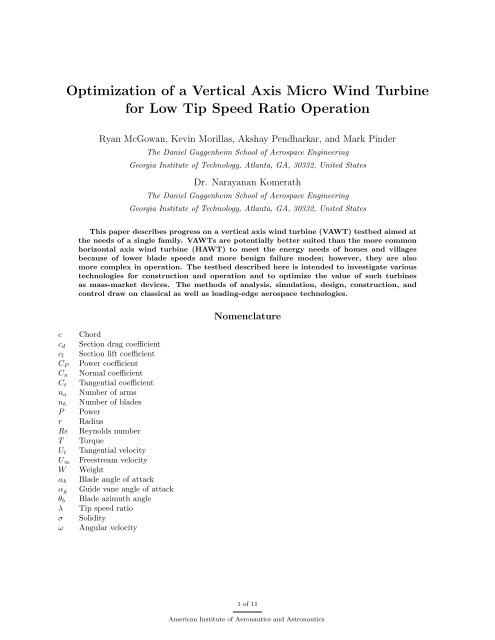
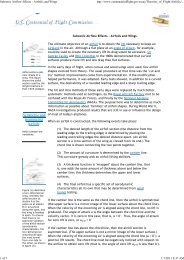

![p density of fluid, kg/m3 [Greek letter rho] V mean velocity of fluid, m ...](https://img.yumpu.com/50595898/1/184x260/p-density-of-fluid-kg-m3-greek-letter-rho-v-mean-velocity-of-fluid-m-.jpg?quality=85)
